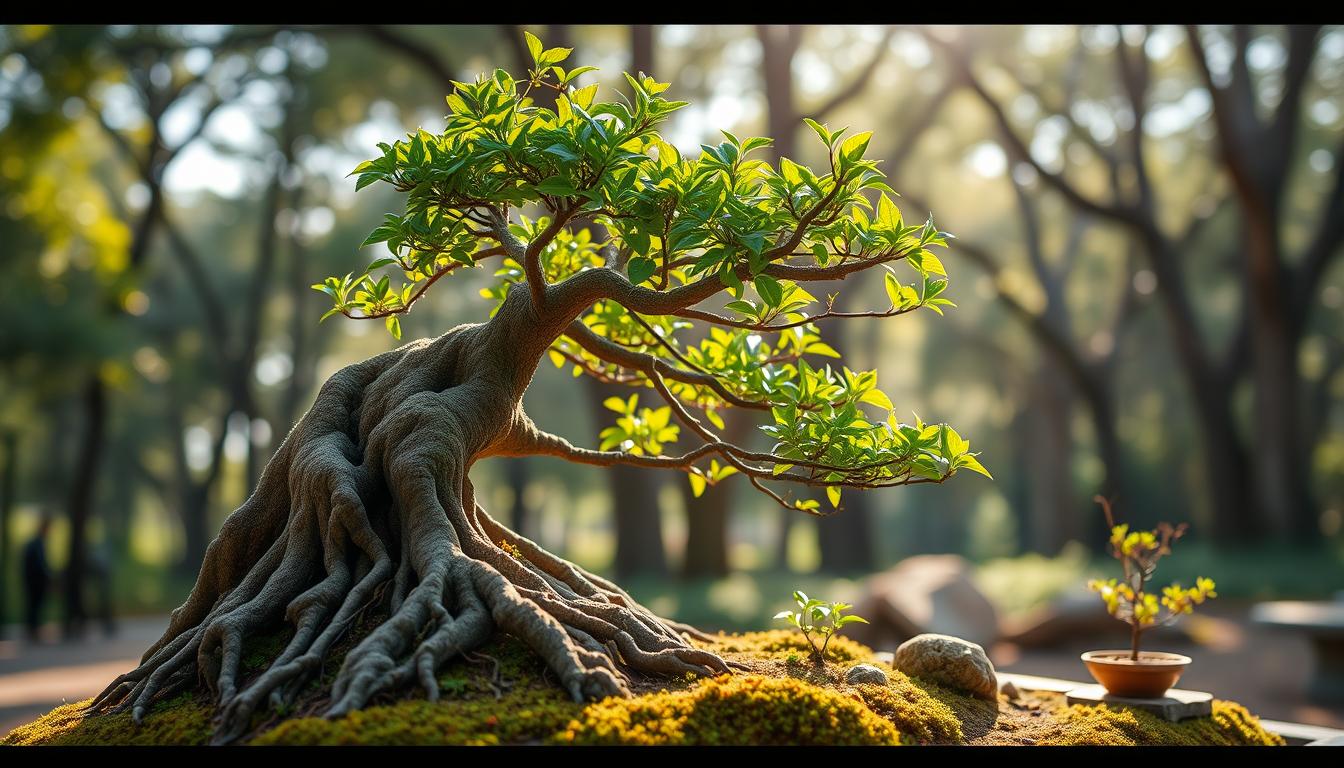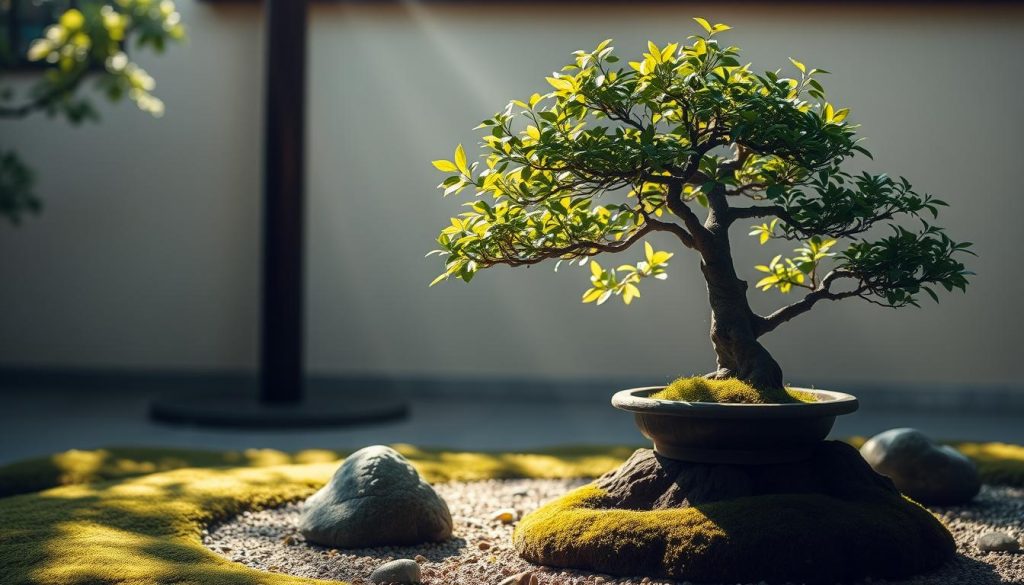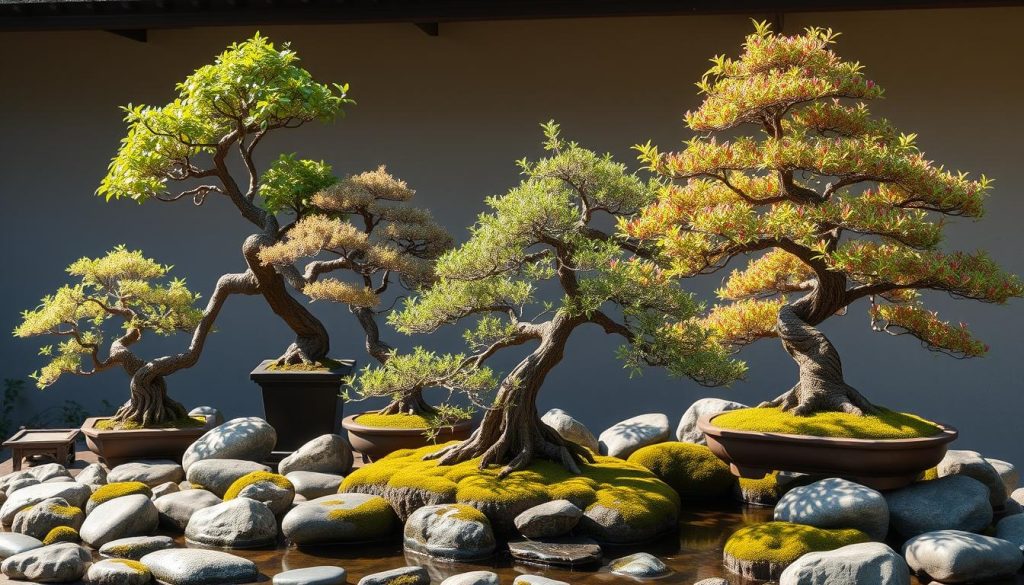Explore the Art of Bonsai: Miniature Tree Mastery

Bonsai is the Japanese art of growing tiny trees in pots. It’s a beautiful tradition that mixes nature’s beauty with human creativity. This article will take you into the world of bonsai, exploring its history, techniques, and cultural importance.
It will also show how growing bonsai brings joy and peace. You’ll learn about bonsai’s roots in Chinese penjing and how it spread to Japan. You’ll see how balance, simplicity, and harmony are key to bonsai.
Key Takeaways
- Bonsai is a centuries-old Japanese art form that involves growing miniature trees in containers.
- Bonsai combines the beauty of nature with the artistry of human cultivation.
- This article will explore the origins, techniques, cultural significance, and joy of nurturing bonsai trees.
- Readers will learn about the ancient roots of bonsai in Chinese penjing and its spread to Japan.
- The article delves into the principles of balance, simplicity, and harmony that define bonsai as an art form.
The Origins and History of Bonsai
The art of bonsai has deep roots in Chinese penjing, dating back to the 7th century AD. This ancient practice inspired the Japanese bonsai art. It first emerged in Japan during the Kamakura period (1185–1333), when the country adopted many Chinese customs.
Ancient Roots in Chinese Penjing
Miniature tree landscapes in China date back 2,300 years. The term “pun tsai” or “tray planting” for bonsai in China was used in the 17th century. These tray landscapes were introduced to Japan over 1,200 years ago, starting the Japanese bonsai tradition.
Spreading to Japan and the Kamakura Period
Bonsai in Japan was first shown in pictures about 800 years ago, in the Kamakura period. By 1800, a group near Osaka called their dwarf trees “bonsai.” This was to distinguish them from regular hachi-no-ki.
After the Great Kanto Earthquake in 1923, Omiya Bonsai Village was established. It was founded by thirty families of professional growers.
Over time, bonsai has grown and changed. Formal bonsai displays in Japan were recognized in the 1930s. The western world began to notice and describe bonsai practices from China and Japan as early as 1604.
Today, bonsai is a highly respected art form. It teaches meditation, contemplation, and harmony with nature.
Understanding the Art of Bonsai
Bonsai is a Japanese art of growing small trees in pots. It’s different from Chinese penjing. Bonsai focuses on the trees, not the whole landscape. This makes it a unique form of art.
Bonsai Defined: The Japanese Tradition
Bonsai is deeply connected to Zen Buddhism. It values balance, simplicity, and harmony. Artists connect with nature while creating these trees.
Every detail of the tree shows the artist’s love for nature. It’s a spiritual art form in Japan.
Mastering Balance, Simplicity, and Harmony
- Bonsai teaches balance, with the tree’s form and size carefully kept.
- It values simplicity, aiming for a minimalist yet beautiful nature scene.
- Harmony is achieved by blending the tree with its pot and surroundings. This creates unity and peace.
By practicing bonsai, artists follow Zen Buddhism. They use the tree to show their bond with nature and seek inner peace.
Types of Bonsai Trees
The world of bonsai is full of different tree species. Each one has its own special traits and changes with the seasons. Popular types in Japan include pine, Japanese maple, cherry, ficus, and juniper.
Pine trees are a favorite among bonsai fans. They stay green all year and are easy to care for. Japanese maples love sunny spots and show off their bright leaves. Cherry bonsai do well in cooler weather and bloom beautifully in spring.
Ficus bonsai are great for indoor spaces. They like steady temperatures and light. Junipers have unique leaves and come in many species for bonsai.
Other interesting bonsai species include jade, weeping fig, boxwood, bald cypress, and lacebark elm. Each one brings its own set of challenges and joys. This makes bonsai a fascinating journey in gardening.
Whether you love Japanese maples, the toughness of pine, or the greenery of ficus, there’s something for everyone. The bonsai world is full of beauty and discovery.
Bonsai Techniques and Styles
The art of bonsai is filled with exciting techniques and many styles. Pruning is key, using sharp tools to shape the bonsai. It sets the tree’s form early on and keeps it small without stopping its growth.
Wiring is another important skill. It uses aluminum or copper wires to guide branches and trunks. Grafting joins two plants to create a new bonsai, adding branches and roots. Repotting is needed when the roots outgrow the container, giving the tree room to grow.
Formal Upright, Informal Upright, and Other Styles
There are many bonsai styles, like the formal upright (Chokkan) and informal upright (Moyogi). The cascade (Kengai) and forest (Yose-ue) styles are also popular. The formal upright is very common, while the semi-cascade is seen near cliffs and water.
Styles like the multi-trunk (Kabudachi) and raft (Ikadabuki) are also beautiful. The exposed root (Nezumi) style shows off the roots, making each bonsai unique and stunning.
Omiya Bonsai Village: A Bonsai Haven
Omiya Bonsai Village is in the heart of Saitama City, Japan. It was started in 1925 for bonsai workers after the Great Kanto Earthquake. Now, it’s a haven for bonsai lovers, showing the beauty of this ancient art.
At Omiya Bonsai Village, you can see many bonsai nurseries. Each one shows the detailed work of these small trees. The Omiya Bonsai Art Museum teaches about bonsai styles and techniques. It shows the skill of local bonsai artists.
Omiya Bonsai Village is also a peaceful place. You can see bonsai gardens in private homes. It’s a place of calm and beauty, perfect for anyone interested in bonsai.
Omiya Bonsai Village is easy to get to from Tokyo. It’s a key place for those wanting to learn about bonsai. Here, you can see beautiful trees and gardens, showing the art and culture of bonsai.
Famous Bonsai Gardens in Japan
Beyond Omiya Bonsai Village, Japan has many famous bonsai gardens. The Shunkaen Bonsai Garden in Tokyo is owned by master Kunio Kobayashi. It has a 1,000-year-old pine tree, one of the oldest in the country.
The Taikan Bonsai Garden is owned by bonsai master Shinji Suzuki. It has some of the world’s highest-quality bonsai trees. Many of these trees are over a century old.
Closer to Omiya Bonsai Village in Saitama, Kimura’s Bonsai Garden is a must-see. It has award-winning bonsai trees like Toryu-no-Mai and Hinoki Ishizuki. These gardens show the beauty and skill of bonsai cultivation.
From Shunkaen’s ancient pines to Taikan’s century-old trees, these bonsai gardens in Japan are truly special. Visiting these places lets you see the beauty and skill of bonsai art.
Bonsai Care and Maintenance
Caring for a bonsai tree is a delicate art. It requires careful observation and a deep understanding of each tree’s needs. Proper care means placing the tree away from direct heat and ensuring it gets enough humidity and sunlight. It also involves managing watering, fertilizing, and making seasonal adjustments.
Watering, Fertilizing, and Seasonal Care
Bonsai trees need a consistent watering schedule. The frequency changes with the seasons. In the growing season, they may need daily or every other day watering. In winter, weekly watering is enough.
It’s important to avoid overwatering and underwatering. Bonsai lovers must watch their trees closely for signs of water needs.
Fertilizing is key for bonsai health. Use a balanced liquid fertilizer at half strength every six weeks in the growing season. This helps the tree grow without harming its roots.
Seasonal changes require adjustments in bonsai care. Pruning, wiring, and repotting are best done when the tree is dormant. Summer months need extra attention for pests and diseases. With careful care, bonsai trees can thrive for years.
- The main cause of most bonsai tree deaths is under-watering, as the shallow soil layer dries out quickly.
- Bonsai trees should be watered when the top soil layer appears dry, with some trees requiring watering once a day depending on type, size, and soil used.
- Overwatering can be detrimental for bonsai trees, with symptoms including yellowing leaves and shriveling branches.
- Bonsai trees should be repotted every two to five years to maintain health and prevent root starvation.
Bonsai Tree Species and Characteristics
The world of bonsai is full of different tree species. Each has its own growth habits, cultural meaning, and beauty. From the elegant Japanese maple to the tough juniper, these small wonders show the beauty of nature.
The Chinese Elm Bonsai is the top indoor tree, showing its popularity. The Carmona Bonsai stands for courage, love, and devotion. The Money Tree Bonsai is known for bringing good luck and wealth.
The Flowering Cherry Blossom Bonsai is a favorite in the UK. It’s known for its beauty and demand. The English Oak Bonsai symbolizes power, strength, and good luck, showing its deep meaning.
- The Japanese Maple, Acer palmatum, is seen as graceful and strong. It reflects peace, love, and honor.
- The Silver Birch Bonsai, Betula pendula, is very hardy. It has beautiful silvery bark, making it stand out.
- Most bonsai trees can grow new buds on old wood. This lets them be pruned and renewed.
Good bonsai trees have small leaves, short internodes, and can handle root changes. There are many types of trees for bonsai, from conifers to broadleaves. This lets fans explore and connect with nature through these living art forms.
The Symbolism and Cultural Significance of Bonsai
Bonsai trees hold deep meaning, showing a balance between nature and human art. Their small size reminds us of the vast world and how everything is connected. They capture the essence of a big tree in a tiny form.
Bonsai trees symbolize long life, wisdom, and peace. Growing these trees teaches us patience, perseverance, and finding beauty in the simple. They also stand for spiritual growth and seeking inner calm, showing the balance between fleeting and lasting things.
Each bonsai tree has its own special meaning. For example, jade bonsai trees mean abundance and success. Ficus bonsai trees symbolize unity and simplicity.
Learning about bonsai helps us see deeper truths and wisdom in these small wonders. Bonsai art shows our deep connection with nature. It also helps us grow personally, meditate, and seek spiritual enlightenment.
- Bonsai trees are symbolic gifts representing harmony, peace, balance, and nature’s goodness.
- Different bonsai species symbolize various virtues and qualities like harmony, peace, strength, wisdom, longevity, growth, and new beginnings.
- Bonsai trees embody simplicity, as growers achieve beauty through natural elements, without added decorations.
- Patience is a key attribute in bonsai cultivation, as rushing the process can set back progress significantly.
- Bonsai symbolizes the cycles of life, encouraging appreciation of each stage, including aging and inevitable change.

By understanding bonsai symbolism, we gain insight into the natural world and our role in it. These small wonders show the lasting beauty and wisdom found in the balance between humans and nature.
Bonsai as a Meditative Practice
Bonsai is more than just growing trees; it’s a journey of self-discovery and peace. It teaches us to focus and find calm. This practice helps us connect with our inner selves.
Pruning and shaping bonsai trees is like a moving meditation. It connects us to nature’s flow. Bonsai reminds us that everything changes, teaching us to live in the moment.
Bonsai offers a quiet space for reflection. It helps us find balance and harmony. By caring for bonsai, we learn to appreciate the world around us more.
- Bonsai as a form of moving meditation, promoting focused awareness and a state of calm
- Bonsai as a metaphor for the impermanence of life, encouraging practitioners to embrace the present moment
- Bonsai care as a sanctuary for stillness and contemplation, fostering inner harmony and balance
- Bonsai practice cultivating a deeper appreciation for nature and mindfulness in daily life
Exploring bonsai can change us deeply. It mixes the physical with the spiritual. Bonsai is a living meditation, showing us the beauty and fleeting nature of life. It guides us to inner peace and self-discovery.
Essential Tools and Materials for Bonsai Cultivation
Bonsai cultivation needs special tools and materials for proper care. These tools help with everything from pruning to shaping branches. Each step in the bonsai journey requires careful equipment selection.
At the core of bonsai care are essential tools. Concave cutters are key for making clean cuts. Wire, made from materials like aluminum and steel, helps shape the trees. Bonsai shears are used for trimming leaves with precision.
Bonsai enthusiasts also use special soil mixes and pots. The soil is made for different trees, helping roots grow well. The pots help with root growth and look good too.
- Concave cutters for precise pruning
- Bonsai wire in various materials for shaping and training
- Bonsai shears for delicate foliage trimming
- Specialized bonsai soil mixes for optimal growth
- Bonsai pots that support healthy root development
The tools and materials for bonsai care show dedication and detail. Each tool has a specific role, helping artists be precise. Knowing the right tools and materials boosts confidence in bonsai practices.
Bonsai Styles and Aesthetics
Bonsai has many styles and aesthetics, each with its own culture, landscape, and art. From the elegant formal upright to the dramatic cascade, bonsai shows the beauty of nature in small form.
Each bonsai style tells a story, showing the beauty and strength of nature. The use of companion plants, accent elements, and special containers adds to the beauty.
Bonsai can take you to peaceful mountains or windy coasts. It lets people explore the endless creativity of this ancient art. Knowing about bonsai styles and aesthetics gives people lots of inspiration and creative freedom.
The formal upright style is the most common, with the tree’s top right over the trunk base. The informal upright style is more natural, with a curve or twist in the trunk.

There are many more styles, like cascade, semi-cascade, and forest. Each style has its own beauty, letting bonsai lovers explore all of creative expression.
Bonsai is a deep conversation with nature, creating living art that blends the natural and artificial. By mastering bonsai, people can enter a world of endless creativity, where nature’s beauty is shown in small, stunning ways.
Conclusion
In the world of bonsai, we find a captivating art that goes beyond just plants. It connects us deeply to nature and offers a space for quiet thought. From China’s ancient penjing to Japan’s stunning bonsai gardens, we’ve seen the beauty and skill of these tiny trees.
Bonsai teaches us about balance and simplicity, showing us the fine line between humans and nature. This journey has filled us with awe and a wish to dive deeper into bonsai’s calm and wisdom.
The art of bonsai has won hearts globally, crossing cultural lines. It shows us the beauty and depth of this ancient craft. It reminds us of the strong bond we can make with nature when we respect and care for it.